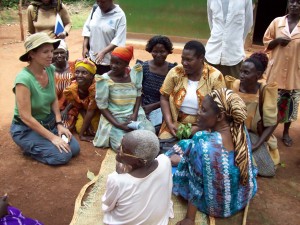Reducing the Gender Gaps in Agriculture: The Experiences of IPM, Peanut, and SANREM CRSPs

Dr. Maria Elisa Christie meets with women in Uganda in a focus group discussion on peanut food preparation techniques. Under Christie's leadership Peanut, SANREM, and IPM CRSPs use a common gender analysis framework.
According to the 2010-2011 State of Food and Agriculture, closing the gender gaps in agriculture has the potential to raise total agricultural output in development countries by between 2.5 and 4 percent and to reduce the number of hungry people in the world by between 12 and 17 percent. Relative to men, however, women have less access to the productive resources that allow them to be as productive as men. If women and men were to enjoy the same access to resources, including land, technology, inputs and credit, models from several countries in Africa suggest that yields from women’s farms could increase between 20 and 30 percent.
Attention to gender issues in agriculture has long been a feature of the CRSP research programs. They have directed research and interventions towards increasing the equitable participation of men and women in agricultural development in multiple ways: increasing the number of women in degree training and capacity building programs, involving women through participatory research activities, hiring women as research staff, and working with women’s groups and men’s groups to achieve development objectives.
In recent years, a number of CRSPs have adopted more systematic approaches to improving the gender analysis capacity of their research programs. Under the leadership of Dr. Maria Elisa Christie, Program Director, Office of International Research and Education and Development at Virginia Tech, the Peanut, SANREM, and IPM CRSPs are integrating gender into research in ways that are changing both the ways research is being conducted and the outcomes for men and women. The three CRSPs are using a common gender analysis framework, the Gender Dimensions Framework (GDF), developed by Cultural Practice LLC under USAID contracts. The framework offers a structured way of identifying and analyzing gender relations in the household, the community, and other institutions to uncover disparities that limit reduce agricultural outcomes and women’s empowerment. Although each of these CRSPs is using the GDF, their experiences in integrating gender into research differ. Some examples are described below:
The Gender Global Theme in the IPM CRSP has three objectives:
1). Increasing the participation of and benefits of research to women; 2). Enhancing the capacity of research teams to integrate gender; and 3). Generating knowledge about gender issues in IPM. As a result, this CRSP has managed to successfully create opportunities for women to assume different roles in the research process. An IPM gender team was created that includes a regional IPM Gender Coordinator and a Country Gender Point Person wherever the CRSP is active. Seven regional workshops have trained a total of 63 men and 90 women on gender methodologies, improving the capacity of Principal Investigators and their research teams to identify and address gender disparities in research.
The SANREM CRSP’s approach integrates gender into its participatory Conservation Agricultural Production Systems (CAPS) with a focus on men’s and women’s knowledge of soil and differences in their access to land and animals. Focus groups, mapping exercises, and participant observation by a student are used to capture differences in how men and women use resources. Household interviews are conducted with both men and women.
Finally, the Peanut CRSP uses a model of working through leading women’s organizations to address aflatoxins in peanut production, processing, and marketing. Working with the National Association of Women’s Organizations of Uganda (NAWOU), researchers are documenting cooking practices involving peanuts and developing information, education and communication (IEC) materials to raise awareness on how to reduce the presence of aflatoxins. The research highlighted three key elements of USAID’s Feed the Future initiative: agriculture, health, and nutrition. By focusing on gender aspects of production and processing, a greater appreciation of women’s role in the prevention of aflatoxin spread emerged. The partnership with NAWOU provided an opportunity to work with a larger network of women’s groups and deepen the contact of researchers with women and men in rural areas. NAWOU Secretary General, Peace Kyamureku sums up the importance of the partnership explaining, “For NAWOU, the Peanut CRSP project was a promotion of grassroots activism as the majority of our membership works in groups. Encouraging and building confidence among such groups can lead to the survival of culture, traditional norms, fighting food insecurity, improving nutritional status, strengthening livelihoods, building capacity and empowerment.”
For more information see: Maria Elisa Christie (2012) “Integrating gender and increasing women’s participation: experiences from Peanut, SANREM, and IPM CRSPs.” Presentation at Hort CRSP Annual Meeting in Bangkok, Thailand.
